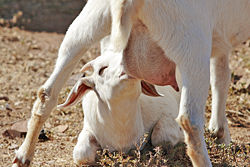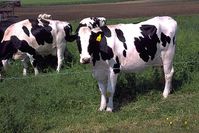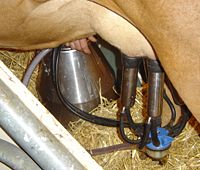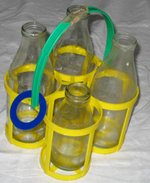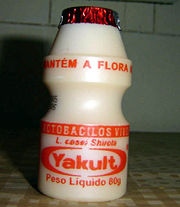Milk
2008/9 Schools Wikipedia Selection. Related subjects: Drink
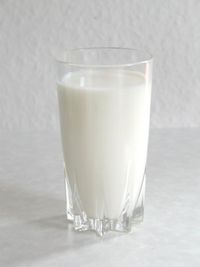
Milk is an opaque white liquid produced by the mammary glands of female mammals (including monotremes). It provides the primary source of nutrition for newborn mammals before they are able to digest other types of food. The early lactation milk is known as colostrum, and carries the mother's antibodies to the baby. It can reduce the risk of many diseases in the baby. The exact components of raw milk varies by species, but it contains significant amounts of saturated fat, protein and calcium as well as vitamin C.
Types of consumption
There are two distinct types of milk consumption: a natural source of nutrition for all infant mammals; and a food product for humans of all ages derived from other animals.
Nutrition for infant mammals
In almost all mammals, milk is fed to infants through breastfeeding, either directly or, for humans, by expressing the milk to be stored and consumed later. Some cultures, historically or currently, continue to use breast milk to feed their children until as old as seven years.
Food product for humans
In many cultures of the world, especially the Western world, humans continue to consume milk beyond infancy, using the milk of other animals (in particular, cows) as a food product. For millennia, cow milk has been processed into dairy products such as cream, butter, yogurt, ice cream, and especially the more durable and easily transportable product, cheese. Industrial science has brought us casein, whey protein, lactose, condensed milk, powdered milk, and many other food-additive and industrial products.
| Top Ten Milk Consumers — 2006 Per Capita Consumption | |||
|---|---|---|---|
| Country | Liters | Cheese (kg) | Butter(kg) |
| 183.9 | 19.1 | 5.3 | |
| 145.5 | 18.5 | 1.0 | |
| 129.8 | 10.5 | 2.9 | |
| 122.9 | 20.4 | 3.3 | |
| 116.7 | 16.0 | 4.3 | |
| 119.1 | 9.6 | 1.0 | |
| 112.5 | 22.2 | 5.6 | |
| 111.2 | 12.2 | 3.7 | |
| 106.3 | 11.7 | 3.7 | |
| 94.7 | 12.2 | 3.3 | |
| Source: Introduction to Dairy Science and Technology: Milk History, Consumption, Production, and Composition | |||
Humans are an exception in the natural world for consuming milk past infancy. Even those humans who drink milk after eating solid foods are uncommon within the whole of humanity. Most humans lose the ability to fully digest milk after childhood (that is, they become lactose intolerant). The sugar lactose is found only in milk, forsythia flowers, and a few tropical shrubs. The enzyme needed to digest lactose, lactase, reaches its highest levels in the small intestines after birth and then begins a slow decline unless milk is consumed regularly. On the other hand, those groups that do continue to tolerate milk often have exercised great creativity in using the milk of domesticated ungulates, not only of cows, but also sheep, goats, yaks, water buffalo, horses, and camels.
The term milk is also used for whitish non-animal substitutes such as soy milk, rice milk, almond milk, and coconut milk. Even the regurgitated substance secreted by glands in the mucosa of their upper digestive tract which pigeons feed their young is called crop milk though it bears little resemblance to mammalian milk.
History
Milking has its advent in the very evolution of placental mammals. While the exact time of its appearance is not known, the immediate ancestors of modern mammals were much like monotremes, including the platypus. Such animals today produce a milk-like substance from glands on the surface of their skin, but without the nipple, for their offspring to drink after hatching from their eggs. Likewise, marsupials, the closest cousin to placental mammals, produce a milk-like substance from a teat-like organ in their pouches. The earliest immediate ancestor of placental mammals known seems to be eomaia, a small creature superficially resembling rodents, that is thought to have lived 125 million years ago, during the Cretaceous era. It almost certainly produced what would be considered milk, in the same way as modern placental mammals.
Animal milk is first known to have been used as human food at the beginning of animal domestication. Cow milk was first used as human food in the Middle East. Goats and sheep were domesticated in the Middle East between 9000 and 8000 BC. Goats and sheep are ruminants: mammals adapted to survive on a diet of dry grass, a food source otherwise useless to humans, and one that is easily stockpiled. The animals were probably first kept for meat and hides, but dairying proved to be a more efficient way of turning uncultivated grasslands into sustenance: the food value of an animal killed for meat can be matched by perhaps one year's worth of milk from the same animal, which will keep producing milk — in convenient daily portions — for years.
Around 7000 BC, cattle were being herded in parts of Turkey. There is evidence from DNA extraction of skeletons from the Neolithic period that people in the northern Europe could not consume milk as they were missing the necessary genes to process lactose. Scientists claim it is more likely that the genetic mutation allowing the digestion of milk arose at some point after dairy farming began. The use of cheese and butter spread in Europe, parts of Asia and parts of Africa. Domestic cows, which previously existed throughout much of Eurasia, were then introduced to the colonies of Europe during the Age of exploration.
Milk was first delivered in bottles on January 11, 1878. The day is now remembered as Milk Day and is celebrated annually. The town of Harvard, Illinois also celebrates milk in the summer with a festival known as Milk Days. Theirs is a different tradition meant to celebrate dairy farmers in the "Milk Capital of the World."
Modern production
| Top Ten Milk Producers — 2005 (1000 tonnes) |
|
|---|---|
| 91,940 | |
| 80,264 | |
| 32,179 | |
| 31,144 | |
| 29,672 | |
| 28,487 | |
| 26,133 | |
| 23,455 | |
| 14,577 | |
| 14,500 | |
| World Total | 372,353 |
| Source: UN Food & Agriculture Organisation | |
In the Western world today, cow milk is produced on an industrial scale. It is by far the most commonly consumed form of milk in the western world. Commercial dairy farming using automated milking equipment produces the vast majority of milk in developed countries. Types of cattle such as the Holstein have been specially bred for increased milk production. According to McGee, 90% of the dairy cows in the United States and 85% in Great Britain are Holsteins (McGee 12). Other milk cows in the United States include Ayrshire, Brown Swiss, Guernsey, Jersey, and Milking Shorthorn. The largest producers of dairy products and milk today are India followed by the United States and China. In India, Amul, a cooperative owned jointly by 2.6 million small farmers was the engine behind the success of Operation Flood.
Price
It was reported in 2007 that with increased world-wide prosperity and the competition of biofuel production for feedstocks, both the demand for and the price of milk had substantially increased world wide. Particularly notable was the rapid increase of consumption of milk in China and the rise of the price of milk in the United States above the government subsidized price.
Physical and chemical structure
Milk is an emulsion or colloid of butterfat globules within a water-based fluid. Each fat globule is surrounded by a membrane consisting of phospholipids and proteins; these emulsifiers keep the individual globules from joining together into noticeable grains of butterfat and also protect the globules from the fat-digesting activity of enzymes found in the fluid portion of the milk. In unhomogenized cow milk, the fat globules average about four micrometers across. The fat-soluble vitamins A, D, E, and K are found within the milkfat portion of the milk (McGee 18).
The largest structures in the fluid portion of the milk are casein protein micelles: aggregates of several thousand protein molecules, bonded with the help of nanometer-scale particles of calcium phosphate. Each micelle is roughly spherical and about a tenth of a micrometer across. There are four different types of casein proteins, and collectively they make up around 80 percent of the protein in milk, by weight. Most of the casein proteins are bound into the micelles. There are several competing theories regarding the precise structure of the micelles, but they share one important feature: the outermost layer consists of strands of one type of protein, kappa-casein, reaching out from the body of the micelle into the surrounding fluid. These Kappa-casein molecules all have a negative electrical charge and therefore repel each other, keeping the micelles separated under normal conditions and in a stable colloidal suspension in the water-based surrounding fluid (McGee 19–20).
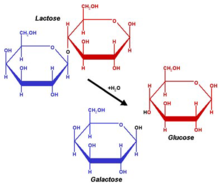
Both the fat globules and the smaller casein micelles, which are just large enough to deflect light, contribute to the opaque white colour of milk. Skimmed milk, however, appears slightly blue because casein micelles scatter the shorter wavelengths (blue compared to red).
The fat globules contain some yellow-orange carotene, enough in some breeds — Guernsey and Jersey cows, for instance — to impart a golden or "creamy" hue to a glass of milk. The riboflavin in the whey portion of milk has a greenish colour, which can sometimes be discerned in skim milk or whey products (McGee 17). Fat-free skim milk has only the casein micelles to scatter light, and they tend to scatter shorter-wavelength blue light more than they do red, giving skim milk a bluish tint.
Milk contains dozens of other types of proteins besides the caseins. They are more water-soluble than the caseins and do not form larger structures. Because these proteins remain suspended in the whey left behind when the caseins coagulate into curds, they are collectively known as whey proteins. Whey proteins make up around twenty percent of the protein in milk, by weight. Lactoglobulin is the most common whey protein by a large margin (McGee 20–21).
The carbohydrate lactose gives milk its sweet taste and contributes about 40% of whole cow milk's calories. Lactose is a composite of two simple sugars, glucose and galactose. In nature, lactose is found only in milk and a small number of plants (McGee 17). Other components found in raw cow milk are living white blood cells. Mammary-gland cells, various bacteria, and a large number of active enzymes are some other components in milk (McGee 16).
Processing
In most Western countries, a centralised dairy facility processes milk and products obtained from milk ( dairy products), such as cream, butter, and cheese. In the United States, these dairies are usually local companies, while in the southern hemisphere facilities may be run by very large nationwide or trans-national corporations (such as Fonterra).
Pasteurization
Pasteurization is used to kill harmful microorganisms by heating the milk for a short time and then cooling it for storage and transportation. Pasteurized milk is still perishable and must be stored cold by both suppliers and consumers. Dairies print expiration dates on each container, after which stores will remove any unsold milk from their shelves. In many countries it is illegal to sell milk that is not pasteurized.
Milk may also be further heated to extend its shelf life through ultra-high temperature treatment ( UHT), which allows it to be stored unrefrigerated, or an even longer lasting sterilization process.
Creaming and homogenization
Upon standing for 12 to 24 hours, fresh milk has a tendency to separate into a high-fat cream layer on top of a larger, low-fat milk layer. The cream is often sold as a separate product with its own uses; today the separation of the cream from the milk is usually accomplished rapidly in centrifugal cream separators. The fat globules rise to the top of a container of milk because fat is less dense than water. The smaller the globules, the more other molecular-level forces prevent this from happening. In fact, the cream rises in cow milk much more quickly than a simple model would predict: rather than isolated globules, the fat in the milk tends to form into clusters containing about a million globules, held together by a number of minor whey proteins (McGee 19). These clusters rise faster than individual globules can. The fat globules in milk from goats, sheep, and water buffalo do not form clusters so readily and are smaller to begin with; cream is very slow to separate from these milks (McGee 19). Milk is often homogenized, a treatment which prevents a cream layer from separating out of the milk. The milk is pumped at high pressures through very narrow tubes, breaking up the fat globules through turbulence and cavitation. A greater number of smaller particles possess more total surface area than a smaller number of larger ones, and the original fat globule membranes cannot completely cover them. Casein micelles are attracted to the newly-exposed fat surfaces; nearly one-third of the micelles in the milk end up participating in this new membrane structure. The casein weighs down the globules and interferes with the clustering that accelerated separation. The exposed fat globules are briefly vulnerable to certain enzymes present in milk, which could break down the fats and produce rancid flavors. To prevent this, the enzymes are inactivated by pasteurizing the milk immediately before or during homogenization. Homogenized milk tastes blander but feels creamier in the mouth than unhomogenized; it is whiter and more resistant to developing off flavours (McGee 23). Creamline, or cream-top, milk is unhomogenized; it may or may not have been pasteurized. Unlike pasteurization, homogenization confers no health or safety benefits to the milk, only the convenience of not needing to shake the bottle oneself.
Nutrition and health
The composition of milk differs widely between species. Factors such as the type of protein; the proportion of protein, fat, and sugar; the levels of various vitamins and minerals; and the size of the butterfat globules and the strength of the curd are among those than can vary. For example:
- Human milk contains, on average, 1.1% protein, 4.2% fat, 7.0% lactose (a sugar), and supplies 72 kcal of energy per 100 grams.
- Cow milk contains, on average, 3.4% protein, 3.6% fat, and 4.6% lactose, 0.7% minerals and supplies 66 kcal of energy per 100 grams. See also Nutritional benefits further on.
Aquatic mammals, such as seals and whales, produce milk that is very rich in fats and other solid nutrients when compared with land mammals' milk.
Nutritional value
| Cow milk (whole) Nutritional value per 100 g (3.5 oz) |
|||||||||||||||||||||||||||||
|---|---|---|---|---|---|---|---|---|---|---|---|---|---|---|---|---|---|---|---|---|---|---|---|---|---|---|---|---|---|
| Energy 60 kcal 250 kJ | |||||||||||||||||||||||||||||
|
|||||||||||||||||||||||||||||
| 100 ml corresponds to 103 g. Percentages are relative to US recommendations for adults. Source: USDA Nutrient database |
|||||||||||||||||||||||||||||
Processed milk began containing differing amounts of fat during the 1950s. A serving (1 cup or 250 ml) of 2%-fat milk contains 285 mg of calcium, which represents 22% to 29% of the daily recommended intake (DRI) of calcium for an adult. Depending on the age, 8 grams of protein, and a number of other nutrients (either naturally or through fortification):
- Biotin and pantothenic acid are B vitamins important for energy production.
- Iodine is a mineral essential for thyroid function.
- Potassium and magnesium are for cardiovascular health.
- Selenium is a cancer-preventive trace mineral.
- Thiamine is a B-vitamin important for cognitive function, especially memory.
- Vitamin A is critical for immune function.
- Vitamin B12 and riboflavin are necessary for cardiovascular health and energy production.
- Vitamins D and K are essential for bone health.
The amount of calcium from milk that is absorbed by the human body is disputed. Calcium from dairy products has a greater bioavailability than calcium from certain vegetables, such a spinach, that contain high levels of calcium- chelating agents, but a similar or lesser bioavailability than calcium from low-oxalate vegetables such as kale, broccoli, or other vegetables in the Brassica genus.
Medical research
Studies show possible links between low-fat milk consumption and reduced risk of arterial hypertension, coronary heart disease, colorectal cancer and obesity. Overweight individuals who drink milk may benefit from decreased risk of insulin resistance and type 2 diabetes. One study has shown that for women desiring to have a child, those who consume full fat dairy products may actually slightly increase their fertility, while those consuming low fat dairy products may slightly reduce their fertility due to interference with ovulation. However, studies in this area are still inconsistent. Milk is a source of Conjugated linoleic acid, a fatty acid that inhibits several types of cancer in mice. CLA has been shown to kill human skin cancer, colorectal cancer and breast cancer cells in vitro studies, and may help lower cholesterol and prevent atherosclerosis; CLA is present only in milk from grass-fed cows.
Other studies suggest that milk consumption may increase the risk of suffering from certain health problems. Milk contains casein, a substance that breaks down in the human stomach to produce casomorphin, an opioid peptide. In the early 1990s it was hypothesized that casomorphin can cause or aggravate autism, and casein-free diets are widely promoted. Studies supporting these claims have had significant flaws, and the data are inadequate to guide autism treatment recommendations. Cow milk allergy (CMA) is as an immunologically mediated adverse reaction to one or more cow milk proteins. Rarely is it severe enough to cause death. Studies described in the book The China Study note a correlation between casein intake and the promotion of cancer cell growth when exposed to carcinogens. However other studies have shown whey protein offers a protective effect against colon cancer.
A study demonstrated that men, and to some degree women, who drink a large amount of milk and consume dairy products were at a slightly increased risk of developing Parkinson's disease. The reason behind this is not fully understood, and it also remains unclear why there is less of a risk for women. Several sources suggest a correlation between high calcium intake (2000 mg per day, or twice the US recommended daily allowance, equivalent to six or more glasses of milk per day) and prostate cancer. A large study specifically implicates dairy. A review published by the World Cancer Research Fund and the American Institute for Cancer Research states that at least eleven human population studies have linked excessive dairy product consumption and prostate cancer, however randomized clinical trial data with appropriate controls only exists for calcium, not dairy produce, where there was no correlation. Medical studies have also shown a possible link between milk consumption and the exacerbation of diseases such as Crohn’s Disease, Hirschsprung's disease–mimicking symptoms in babies with existing cow milk allergies, severe gastroesophageal reflux disease in infants and children hypersenstitive to milk, and the aggravation of Behçet's disease.
Since November 1993, with FDA approval, Monsanto has been selling recombinant bovine somatotropin (rbST)--or rBGH--to dairy farmers. Additional bovine growth hormone is administered to cattle in order to increase their milk production, though the hormone also naturally fosters liver production of insulin-like growth factor 1 (IGF1). The deposit thereof in the milk of rBGH-affected cattle has been the source of concern; however, all milk contains IGF1 since all milking cows produce bovine growth hormone naturally. The IGF1 in milk from rBGH-affected cattle does not vary from the range normally found in a non-supplemented cow. Elevated levels of IGF1 in human blood has been linked to increased rates of breast, colon, and prostate cancer by stimulating their growth, though this has not been linked to milk consumption. The EU has recommended against Monsanto milk. In addition, the cows receiving rBGH supplements may more frequently contract an udder infection known as mastitis. Milk from rBGH-affected cattle is banned in Canada, Australia, New Zealand, and Japan due to the mastitis problems. On June 9, 2006 the largest milk processor in the world and the two largest supermarkets in the United States-- Dean Foods, Wal-Mart, and Kroger--announced that they are "on a nationwide search for rBGH-free milk." No study has indicated that consumption of rBST-produced milk increases IGF1 levels, nor has any study demonstrated an increased risk of any disease between those consuming rBST and non-rBST produced milk. In 1994, the FDA stated that no significant difference has been shown between milk derived from rBST-treated and non-rBST-treated cows, and that no test exists which can differentiate between milk from rBST-treated and non-rBST treated cows.
Milk may contain varying levels of white blood cells depending upon the health of the source animals, according to guidelines set up by the Food and Drug Administration and statistics reported by the dairy industry. Although not considered a human health issue by most authorities, elevated white blood cell levels indicate an immune response by cattle, due in part to mastitis. There are concerns regarding the transmission of bovine paratubeculosis through somatic cells to humans, but the evidence is largely inconclusive.
Lactose intolerance
Lactose, the disaccharide sugar component of all milk must be cleaved in the small intestine by the enzyme lactase in order for its constituents ( galactose and glucose) to be absorbed. The production of this enzyme declines significantly after weaning in all mammals including humans(except for most northern westerners and a few other ethnic groups, lactase decline occurs after weaning, sometime between the ages of two and five). Once lactase levels have decreased sufficiently, consumption of small amounts of lactose can cause diarrhea, intestinal gas, cramps and bloating, as the undigested lactose travels through the gastrointestinal tract and serves as nourishment for intestinal microflora who excrete gas.
Varieties and brands
Milk products are sold in a number of varieties based on types/degrees of
- age (e.g., cheddar),
- additives (e.g., vitamins),
- coagulation (e.g., cottage cheese),
- farming method (e.g., organic, grass-fed).
- fat content (e.g., half and half),
- fermentation (e.g., buttermilk),
- flavoring (e.g., chocolate),
- homogenization (e.g., raw milk),
- mammal (e.g., cow, goat, sheep),
- packaging (e.g., bottle),
- sterilization (e.g., pasteurization),
- water content (e.g., dry milk),
Organic Milk (in the United States) or Bio-Milk & Biologique Milk (in Europe) is milk produced without the use of chemical herbicides or pesticides, and generally with more natural fertilizers and higher standards for the animals, and is now easy to find on the shelves in many areas. Demeter certified milk is produced with biodynamic agriculture methods and is similar in standards to organic milk and biological milk, with a few special farm procedures added that are biodynamic-specific.
Cow milk is generally available in several varieties according to approximate butterfat content. See fat content of milk.
Additives and flavoring
In countries where the cattle (and often the people) live indoors, commercially sold milk commonly has vitamin D added to it to make up for lack of exposure to UVB radiation.
Reduced fat milks often have added vitamin A to compensate for the loss of the vitamin during fat removal; in the United States this results in reduced fat milks having a higher vitamin A content than whole milk.
To aid digestion in those with lactose intolerance, milk is available in some areas with added bacterial cultures such as Lactobacillus acidophilus (" acidophilus milk") and bifidobacteria (" a/B milk"). Another milk with Lactococcus lactis bacteria cultures (" cultured buttermilk") is often used in cooking to replace the traditional use of naturally soured milk, which has become rare due to the ubiquity of pasteurization which kills the naturally occurring lactococcus bacteria.
Milk often has flavoring added to it for better taste or as a means of improving sales. Chocolate flavored milk has been sold for many years and has been followed more recently by such other flavours as strawberry and banana.
South Australia has the highest consumption of flavored milk per person in the world, where Farmers Union Iced Coffee outsells Coca-Cola, a success shared only by Inca Kola in Peru and Irn-Bru in Scotland.
Switzerland has a soft drink based on milk that tastes and looks much like SevenUp. This popular "milk-cola", named Rivella, is in fact the national soft drink and even comes complete in low calorie & low sugar varieties. In spite of what might be expected, it does not taste like milk.
Distribution
Because milk spoils so easily, it should, ideally, be distributed as quickly as possible. In many countries milk used to be delivered to households daily, but economic pressure has made milk delivery much less popular, and in many areas daily delivery is no longer available. People buy it chilled at grocery or convenience stores or similar retail outlets. Prior to the widespread use of plastics, milk was sold in wax-coated paper containers; prior to that milk was often distributed to consumers in glass bottles; and before glass bottles, in bulk that was ladled into the customer's container.
In the UK, milk can be delivered daily by a milkman who travels his local milk round (route) using a battery-powered milk float during the early hours. Milk is delivered in 1 pint glass bottles with aluminium foil tops. Silver top denotes full cream unhomogenized; red top full cream homogenized; red/silver top semi-skimmed; blue/silver check top skimmed; and gold top channel island.
Empty bottles are rinsed before being left outside for the milkman to collect and take back to the dairy for washing and reuse. Currently many milkmen operate franchises as opposed to being employed by the dairy and payment is made at regular intervals, by leaving a check; by cash collection; or direct debit.
Although there was a steep decline in doorstep delivery sales throughout the 1990s, the service is still prominent, as dairies have diversified and the service is becoming more popular again. The doorstep delivery of milk is seen as part of the UK's heritage, and is relied upon by people up and down the country.
In New Zealand, milk is no longer distributed in glass bottles. In rural India, milk is delivered daily by a local milkman carrying bulk quantities in a metal container, usually on a bicycle; and in other parts of metropolitan India, milk is usually bought or delivered in a plastic bags or cartons via-shops or supermarkets.
In the United States bottles were replaced with milk cartons, which are tall paper boxes with a square cross-section and a peaked top that can be folded outward upon opening to form a spout. Now milk is increasingly sold in plastic bottles. First the gallon and half-gallon sizes were sold in plastic jugs while the smaller sizes were sold in milk cartons. Recently milk has been sold in smaller resealable bottles made to fit in automobile cup holders.
The half-pint milk carton is the traditional unit as a component of school lunches. In the U.S., pictures of missing children were printed on the larger milk cartons as a public service until it was determined that this was disturbing to children.
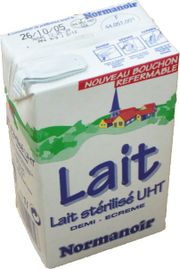
Milk preserved by the UHT process is sold in cartons often called a brick that lack the peak of the traditional milk carton. Milk preserved in this fashion does not need to be refrigerated before opening and has a longer shelf life than milk in ordinary packaging. It is more typically sold unrefrigerated on the shelves in Europe than in America.
Glass milk containers are now rare. Most people purchase milk in bags, plastic jugs or waxed-paper cartons. Ultraviolet (UV) light from fluorescent lighting can alter the flavor of milk, so many companies that once distributed milk in transparent or highly translucent containers are now using thicker materials that block the UV light. Many people feel that such "UV protected" milk tastes better.
Milk comes in a variety of containers with local variants:
- Australia and New Zealand: Distributed in a variety of sizes, most commonly in aseptic cartons for up to 1 litres, and plastic screw-top bottles beyond that with the following volumes; 1.1L, 2L, and 3L. 1 litre Bags are starting to appear in supermarkets, but have not yet proved popular. Most UHT-milk is packed in 1 or 2 litre paper containers with a sealed plastic spout.
- Brazil: Used to be sold in cooled 1 litre bags, just like in South Africa. Nowadays the most common form is 1 litre aseptic cartons containing UHT skimmed, semi-skimmed or whole milk, although the plastic bags are still in use.
- Canada: 1.33 litre plastic bags (sold as 4 litres in 3 bags) are widely available in some areas (especially Ontario and Québec), although the 4 litre plastic jug has supplanted them in western Canada. Other common packaging sizes are 2 litre, 1 litre, 500 millilitre, and 250 millilitre cartons, as well as 4 litre, 1 litre, 250 mL aseptic cartons and 500 millilitre plastic jugs.
- China: Sweetened milk is a drink popular with students of all ages and is often sold in small plastic bags complete with straw. Adults not wishing to drink at a banquet often drink milk served from cartons or milk tea.
- Parts of Europe: Sizes of 500 millilitres, 1 litre (the most common), 2 litres and 3 litres are commonplace.
- Hong Kong - milk is sold in glass bottles (220 mL), cartons (236 mL and 1L), plastic jugs (2 litres) and aseptic cartons (250 mL).
- India: Commonly sold in 500 mL plastic bags. It is still customary to serve the milk boiled, despite pasteurization. Milk is often buffalo milk. Flavored milk is sold in most convenience stores in waxed cardboard containers. Convenience stores also sell many varieties of milk (such as flavored and ultra-pasteurized) in different sizes, usually in aseptic cartons.
- Indonesia: Usually sold in 1 litre cartons, but smaller, snack-sized cartons are available.
- Israel: Non-UHT milk is most commonly sold in 1 litre waxed cardboard boxes and 1 litre plastic bags. It may also be found in 0.5L and 2L waxed cardboard boxes, 2L plastic jugs and 1L plastic bottles. UHT milk is available in 1 litre (and less commonly also in 0.25L) carton "bricks".
- Japan: Commonly sold in 1 litre waxed cardboard boxes. In most city centers there is also home delivery of milk in glass jugs. As seen in China, sweetened and flavored milk drinks are very popular to see in vending machines.
- South Africa: Commonly sold in 1 litre bags. The bag is then placed in a plastic jug and the corner cut off before the milk is poured.
- South Korea: sold in cartons (180mL, 200mL, 500mL 900mL, 1L, 1.8L, 2.3L), plastic jugs (100Ml and 1.8L), aseptic cartons (180mL and 200mL) and plastic bags (100mL).
- Poland: UHT milk is mostly sold in aseptic cartons (500mL, 1L, 2L), and non-UHT in 1L plastic bags or plastic bottles. Milk, UHT is commonly boiled, despite being pasteurized.
- Turkey: Commonly sold in 500 mL or 1L cartons or special plastic bottles. UHT milk is more popular. Milkmen also serve in smaller towns and villages.
- United Kingdom: Most stores still stock Imperial sizes: 1 pint (568 mL), 2 pints (1.136 L), 4 pints (2.273 L), 6 pints (3.408 L) or a combination including both metric and imperial sizes. Glass milk bottles delivered to the doorstep by the milkman are typically pint-sized and are returned empty by the householder for repeated reuse. Milk is also sold at supermarkets in either aseptic cartons or HDPE bottles. Milk can still be legally sold by the Imperial pint in reusable bottles in the UK under EU regulations (a distinction only shared with beer and cider), whilst a growing number of manufacturers such as Northern Foods now sell milk in 1 and 2 litre bottles.
- United States: Commonly sold in gallon, half-gallon and quart containers ( U.S. customary units) of rigid plastic or, occasionally for sizes less than a gallon, waxed cardboard, although bottles made of opaque PET are starting to become more commonplace in all smaller sizes. The US single-serving size is usually the half-pint (about 240 ml). Occasionally dairies will deliver milk straight to customers in coolers filled with glass bottles (usually half-gallon). Some convenience store chains in the United States (such as Kwik Trip in the Midwest) sell milk in 1/2 gallon bags.
- Uruguay: Commonly sold in 1 litre bags. The bag is then placed in a plastic jug and the corner cut off before the milk is poured.
Practically everywhere, condensed milk and evaporated milk is distributed in metal cans, 250 and 125 ml paper containers and 100 and 200 mL squeeze tubes, and powdered milk (skim and whole) is distributed in boxes or bags.
Spoilage and fermented milk products
When raw milk is left standing for a while, it turns " sour". This is the result of fermentation, where lactic acid bacteria ferment the lactose inside the milk into lactic acid. Prolonged fermentation may render the milk unpleasant to consume. This fermentation process is exploited by the introduction of bacterial cultures (e.g. Lactobacilli sp., Streptococcus sp., Leuconostoc sp., etc) to produce a variety of fermented milk products. The reduced pH from lactic acid accumulation denatures proteins and caused the milk to undergo a variety of different transformations in appearance and texture, ranging from an aggregate to smooth consistency. Some of these products include sour cream, yoghurt, cheese, buttermilk, viili, kefir and kumis. See Dairy product for more information.
Pasteurization of cow milk initially destroys any potential pathogens and increases the shelf-life , but eventually results in spoilage that makes it unsuitable for consumption. This causes it to assume an unpleasant odour, and the milk is deemed non-consumable due to unpleasant taste and an increased risk of food poisoning. In raw milk, the presence of lactic acid-producing bacteria, under suitable conditions, ferments the lactose present to lactic acid. The increasing acidity in turn prevents the growth of other organisms, or slows their growth significantly. During pasteurization however, these lactic acid bacteria are mostly destroyed.
In order to prevent spoilage, milk can be kept refrigerated and stored between 1 and 4 degrees Celsius in bulk tanks. Most milk is pasteurized by heating briefly and then refrigerated to allow transport from factory farms to local markets. The spoilage of milk can be forestalled by using ultra-high temperature ( UHT) treatment; milk so treated can be stored unrefrigerated for several months until opened. Sterilized milk, which is heated for a much longer period of time, will last even longer, but also loses more nutrients and assume a different taste. Condensed milk, made by removing most of the water, can be stored in cans for many years, unrefrigerated, as can evaporated milk. The most durable form of milk is milk powder, which is produced from milk by removing almost all water. The moisture content is usually less than five percent in both drum and spray dried milk powder.
